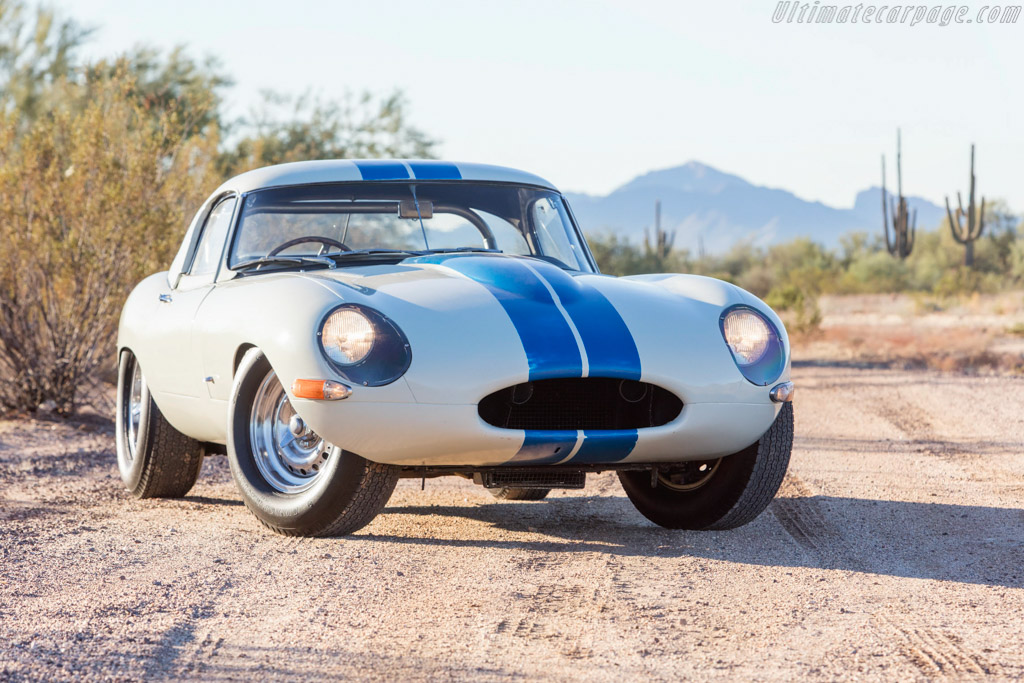 |
Conceived as as a road car, the Jaguar E-Type was nevertheless a regular sight at racing tracks shortly after its launch at the 1961 Geneva Motorshow. With its chassis and engine design derived from the three-time Le Mans winning D-Type this was hardly a surprise. To keep the costs of production down, Jaguar fitted the E-Type with a steel body. This proved to be a big handicap when the E-Types faced thoroughbred rivals like the Ferrari 250 GT(O), Aston Martin DB4 GT Zagato and Shelby Cobra, which all used feather light aluminium bodies. One of the most successful of these early racing E-Types was the John Coombs prepared example that was raced by Roy Salvadori and Graham Hill in 1961 and 1962. The only upgrades fitted on this car were a wide-angle head and triple Webers. The performance of Salvadori and Hill in the steel E-Type sparked an interest inside Jaguar's dormant competition department at the end of 1962. It was decided to construct a proper competition version of the E-Type and John Coombs was invited to the factory to have his successful machine serve as the prototype. To retain the E-Type's homologation as a GT car, the body could be modified but not the chassis, so the steel monocoque was retained. A brand new body was constructed that looked virtually identical to the production road car but was fabricated completely from aluminium. To improve the aerodynamics a separate 'hard-top' roof was added, which sported a small vent at the rear. Some of the later cars were bodied with full fast-back Coupe bodies that proved to be even more efficient. Under the lightweight shell the new competition E-Type also featured changes. The biggest was an aluminium cylinder block instead of the cast-iron lump fitted in the road cars. Together with the revised body, this helped cut the weight by over 200 kg. The revised 3.8 litre engine was also fitted with Lucas fuel injection, which helped lift the power to well over 300 bhp. All of this was transferred to the rear wheels through a five-speed, close-ratio gearbox. Simply dubbed the 'Lightweight E-Type', Jaguar's new racing car was entrusted to privateer entrants, some of whom received factory support. Among them was of course John Coombs but also American Briggs Cunningham, who ordered three cars for an all-out assault on Le Mans. One of the first major outings for the Lightweight was the 1963 Sebring 12 Hours where two examples placed 7th and 8th overall. They finished 1st and 2nd in the four-litre GT class but were beaten by three Ferrari 250 GTOs that raced in the under three-litre class.
At Le Mans the three Lightweight E-Types looked absolutely splendid in the Cunningham colours of white with two blue-stripes. The high-speed track had traditionally favoured Jaguars, so hopes for a good result were high. The cars were competitive in the practice session but the race started disastrous; two of the three E-Types were out before the 40th lap was completed. The surviving example finished 9th overall and 2nd in class behind a Cobra. Most worrying of all was that the smaller engined Ferrari 250 GTOs turned out to be considerably quicker. While the Lightweight E-Type was proven to be 'too little, too late' in the major events, it did score the odd win in national events. In England Peter Sutcliffe was very competitive in his example and German Jaguar distributor Peter Lindner won several races in his coupe-bodied Lightweight. Sadly he suffered a fatal crash behind the wheel of his car at Montlhery in the fall of 1964. By that time, Jaguar had long lost interest in the project. Eventually only 12 examples were constructed, including the Coombs prototype. Whether the E-Type could have been a success on the racing track had Jaguar built a competition version immediately, we will never know. The Lightweight built two years later showed promise but failed to perform on the big stage. Despite the average track-record, the Lightweight E-Types are well sought after today, demanding seven figure prices in Pounds, Dollars and Euros. The most amazing development is the performance the cars have shown on track. The Lightweight E-Types have been particularly successful in the Goodwood Revival TT race, winning against Ferraris and Cobras they could not touch in period. |
You need to be a member of The Vintage Racing League to add comments!
Join The Vintage Racing League